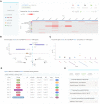QTLbase: an integrative resource for quantitative trait loci across multiple human molecular phenotypes
- PMID: 31598699
- PMCID: PMC6943073
- DOI: 10.1093/nar/gkz888
QTLbase: an integrative resource for quantitative trait loci across multiple human molecular phenotypes
Abstract
Recent advances in genome sequencing and functional genomic profiling have promoted many large-scale quantitative trait locus (QTL) studies, which connect genotypes with tissue/cell type-specific cellular functions from transcriptional to post-translational level. However, no comprehensive resource can perform QTL lookup across multiple molecular phenotypes and investigate the potential cascade effect of functional variants. We developed a versatile resource, named QTLbase, for interpreting the possible molecular functions of genetic variants, as well as their tissue/cell-type specificity. Overall, QTLbase has five key functions: (i) curating and compiling genome-wide QTL summary statistics for 13 human molecular traits from 233 independent studies; (ii) mapping QTL-relevant tissue/cell types to 78 unified terms according to a standard anatomogram; (iii) normalizing variant and trait information uniformly, yielding >170 million significant QTLs; (iv) providing a rich web client that enables phenome- and tissue-wise visualization; and (v) integrating the most comprehensive genomic features and functional predictions to annotate the potential QTL mechanisms. QTLbase provides a one-stop shop for QTL retrieval and comparison across multiple tissues and multiple layers of molecular complexity, and will greatly help researchers interrogate the biological mechanism of causal variants and guide the direction of functional validation. QTLbase is freely available at http://mulinlab.org/qtlbase.
© The Author(s) 2019. Published by Oxford University Press on behalf of Nucleic Acids Research.
Figures




References
Publication types
MeSH terms
LinkOut - more resources
Full Text Sources

